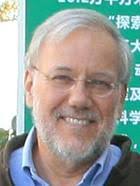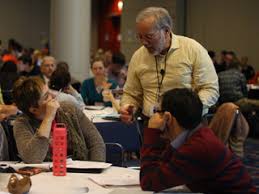
I’ve been involved in science education since 1972 when I decided to become a science teacher. While I loved science and working in the science lab, I wanted to help others learn science, especially those who struggled with the ideas but really wanted to succeed. I have always loved science teaching and helping others who struggle to understand science. But today, 47 years later from when I made the decision to enter the teaching profession, I’m more excited and hopeful about science education than I have ever been. Why is that? Well, for the first time in science education from the East Coast to the Midwest to the West Coast, there is a swelling of enthusiasm by science teachers, administrators, policymakers and community members to shift the teaching and learning of science from kindergarten through college from learning about the principles and facts of science to environments where students figuring out phenomena using scientific ideas and scientific practices. And CREATE for STEM is at the forefront of these efforts at the state, national and global levels.
What is so unique about today that propels these changes? Well, there now exists a solid body of research that provides us with direction. Don’t get me wrong, we have much to learn, especially with how to bring about sustained change, but people – teachers, administrators, researchers and policymakers, parents and community members – stand behind these ideas to make changes in education that will enhance the quality of life for children and make our world a better place. Don’t get me wrong – not everyone is behind this movement, but we are making progress. And I know that more is behind this movement than just scientific evidence.

Propelled by the Taking Science to School (NRC, 2008) and the Framework for K-12 Science Education (NRC, 2012) and a new volume released by National Academy of Science, Science and Engineering in 6 – 12: Investigation and Design at the Center (NAS, 2018), changes in how science teaching occurs in K – 16 classrooms is happening. Why are people listening to these reports? There are a variety of reasons from the realization that our children are not able to apply important ideas to solve problems and make decision, to our children are not being motivated to learn science and engineering, and to continue to their education and go into STEM fields, to the jobs of the future that will require individuals to think, solve problems and use knowledge. The ideas presented in the documents I listed above are based on a solid foundation of research from the learning sciences and cognitive and education research. One must also realize that the scholars who worked on these documents are some of the best researchers, policymakers, and practitioners in our country. And these reports are consensus studies; that means not only do the committees that wrote the reports need to agree but that the documents are also sent out for external review and that the members of National Academy of Science also need to reach consensus on the conclusions and that the conclusions are based on evidence. I think I would have little argument by claiming that the members of the National Academy of Science are the most prestigious body of scientists in the world.
Below are two excerpts from the first two conclusions from Investigation and Design at the Center. Remember these conclusions are based on the best evidence we have to date on the teaching and learning of science and that they were approved by the committee, members of the community at large, and the National Academy of Science.
- Conclusion 1: Engaging students in learning about natural phenomena and engineering challenges via science investigation and engineering design increases their understanding of how the world works. (NAS, 2018, Page 4)
- Conclusion 2: Teachers can use students’ curiosity to motivate learning by choosing phenomena and design challenges that are interesting and engaging to students, including those that are locally and/or culturally relevant. (NAS, 2018, Page 4)
Why did I choose these two conclusions? When students engage in making sense of phenomena or design challenges that are anchored in their lives and culture, they are involved in the doing of science and engineering. They are agents who are doing the work of trying to make sense of the world – how can I explain that phenomena? What is the best solution for that problem? Such learning is challenging because students are doing cognitive work, even though the work is scaffolded by teachers. But the process is also empowering. Students and teachers develop a sense of accomplishment – students learn, “I can do this” and they develop knowledge that they can use throughout their lives, not only to learn more but also to make sense of the world.
CREATE researchers have taken the approach of designing project-based learning environments to engage learners and promote usable knowledge. We have much to learn about how to design project-based learning environments to foster such useable knowledge and we have also learned how to provide teachers with long term, sustained professional learning experiences to support students in such learning environments. Moreover, teachers need to be our close collaborators in such efforts. Science education researchers and learning scientists have much to offer, but we can’t do it alone. Teachers also have much wisdom and experience in working with a variety of learners. As a community, we need to capitalize on what everyone brings to the table.
Above I made a very strong claim that CREATE for STEM is at the forefront of the efforts to bring about change in teaching and learning at the state and national level and throughout the globe. But what is my evidence for making such a broad claim? To start, the Detroit Public School Community District (DPSCD) has implemented the CREATE’s Multiple-Literacies in Project-Base Learning (ML-PBL) materials for grades 3, 4 and 5. That will be an amazing impact on the lives of elementary children in DPSCD schools. But that isn’t all; DPSCD has also adopted CREATE’s Interaction curriculum for all 9th-grade students in the district. Nationally, Los Angeles Unified School District (LAUSD) has also adopted CREATE’s Interaction unit for its 9th-grade curriculum. CREATE professional development facilitators are providing professional learning for over 200 LAUSD science teachers this summer. While Detroit and LA only represent a fraction of the children in our nation, CREATE is having a powerful impact on the lives of learners who traditionally have not experienced optimal science learning. But there is more. Our high school materials developed in the Crafting Engaging Science Environments (CESE) project is also impacting learners in Detroit, LA and in Southern California. Globally, CREATE is also having an impact. Science education researchers from the Beijing Normal University in China are translating one of our 3rd-grade units from ML-PBL, our middle school unit on energy developed through the ELeVATE project, and a high school physics unit from the CESE. Their goal is to use these units in China to promote the use of project-based learning as a viable instructional strategy.
Learning scientists and science education researchers from Beijing Normal University see CREATE’s materials and our project-based learning approach as an avenue to promote students using knowledge and developing a sense of wonderment about the world. However, they also see the materials as fostering creativity and the ability to act independently to carry-out challenging tasks (that is, build agency). Educational researchers from the University of Helsinki have been our partners in CESE to improve the engagement of high school students in physics and chemistry. And science education researchers from the Weizmann Institute of Science in Israel and IPN in Germany our collaborators on the ELeVATE project.

While I may be approaching the final years of my professional career, I’m the most excited I have ever been about the potential to bring about change to support all learners. We still have much to learn about designing project-based learning environments that will support learners using knowledge, developing a sense of wonderment about the world, fostering creativity and promoting agency. We also need to learn more about how to build professional learning communities to foster and sustain such learning environments. Researchers and professional development facilitators from CREATE in collaborations with others have done much to move the field forward. We have made progress on our quest to improve the teaching and learning of science for all students K - 16. I’m am proud to work along with all of those in the CREATE community to make a difference in the lives of all learners. We need to continue to work hard to complete this quest.
References
National Research Council. (2007). Taking science to school: Learning and teaching science in grades K-8. National Academies Press.
National Research Council. (2012). A framework for K-12 science education: Practices, crosscutting concepts, and core ideas. National Academies Press.
National Academies of Sciences, Engineering, and Medicine. (2018). Science and Engineering for Grades 6-12: Investigation and Design at the Center. Washington, DC: The National Academies Press. DOI: https://doi.org/10.17226/25216.
NGSS Lead States. (2013). Next-generation science standards: For states, by states. National Academies Press.


